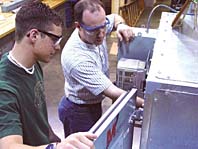
Bergmann’s program is the first secondary education-level HVACR program in the country to receive accreditation through the Partnership for Air-Conditioning, Heating, Refrigeration Accreditation (PAHRA). According to Bergmann, following and establishing standards such as those endorsed by PAHRA is the key to keeping high school HVAC programs afloat.
“Programs are shutting down because they are not teaching what industry wants,” he said. “PAHRA is the only accreditation that is backed by industry.”

Proving Your Worth
The HVAC program at the Cuyahoga Valley Career Center earned the Residential A/C and Heating portion of PAHRA. Bergman said that the program will begin the process of going after the other two portions of PAHRA: Light Commercial A/C and Heating and Commercial Refrigeration.Bergmann said that the reason for trying to obtain PAHRA accreditation is simple.
“We have a very good school and we are under good leadership,” he said. “There was no excuse not to do it.”
Bergmann said that he wanted to obtain accreditation for the program, but was not sure what accreditation to use. It wasn’t until leaders in the industry suggested PAHRA that Bergmann looked into it and started the process.
It took Bergmann less than a year to prepare all of the necessary requirements for PAHRA and earn the accreditation. This included compiling everything the program does, from curriculum to student ratios and passing rates. All of this then had to be verified by a site visit.
Bergmann had reasons to put his nose to the grindstone and get the accreditation. First, Bergmann was told that if he submitted his self-study material, he would be the first secondary school in the nation to receive a site visit and possibly the first secondary school to receive the honor.
But more important, Bergmann said that he wanted to earn the accreditation as soon as possible in order for it to benefit his students. He said he did not want any more students graduating from the program without being able to say that their program was PAHRA accredited.
In November of 2002, PAHRA team leader Bob Feathers, along with four members of the local Cleveland industry, visited Bergmann to make sure that his program lived up to PAHRA standards.
“This was the most challenging part,” said Bergmann, “just dealing with the stress of having five people come out and watch you for two days.”
But at the same time, Bergmann said that having members of the local industry evaluate his program was a definite benefit. He explained that area contractors got a better look at what the school can provide, which Bergmann said would help his students find jobs.

Contractors Take Notice
Since earning the accreditation, Bergmann said that the program has seen nothing but benefits.The first is the attention his program gets locally and nationally from industry.
According to Bergmann, many of the HVACR companies in the Cleveland area are becoming more educated on such standards as North American Technician Excellence (NATE), the Industry Competency Exam (ICE), and PAHRA. Bergmann said that PAHRA is one step in getting future technicians to the point where they will successfully pass the ICE and NATE exams.
Bergmann also said that since putting PAHRA in place, the program is taken more seriously by parents and students.
“Parents who had no intention of sending their child into a vocational program are getting more interested,” he said. “We are now held to a higher standard, and it’s given us a little bit of clout.”
Bergmann also explained that because of the higher standard, his program gets more students of a higher caliber.
This was proved recently when one of his students was hired by Energy Management Specialists Inc. (EMS), a company that was honored as one of The News’ Best Contractors to Work For in 2002.
Bergmann said that his student saw the article on EMS in The News and decided that was the company he would try to work for.
The 17-year-old student had to go through six interviews and take an entrance exam that was written for technicians who have had about five years of experience in the field. Bergmann’s student passed that test and was hired by EMS.
“That gives some validity to our program,” he said. “These programs are really nothing without quality students.”
And Bergmann wants contractors to notice the students he has. First, the instructor allows contractors to come into his classroom to do job interviews with his students. This lets them see not only the caliber of the students, but the success of the course and the programs, too.
He also holds several open house meetings for area contractors.
“We tell the contractors that we have raised the bar,” explained Bergmann. “We also let them take a look at our self-study. This shows them what we do here and that what we do is what industry wants.”
Bergman said that other schools have come in to see his program and find out more about PAHRA. The instructor is so passionate about what PAHRA can do that he has set out to convince the Ohio Department of Education to make PAHRA the standard for HVACR programs throughout the state.
“PAHRA is backed by 95 percent of the industry,” said Bergmann. “The accreditation says what industry wants. It doesn’t matter what instructors want, it’s what industry wants.”
Publication date: 06/23/2003


Report Abusive Comment